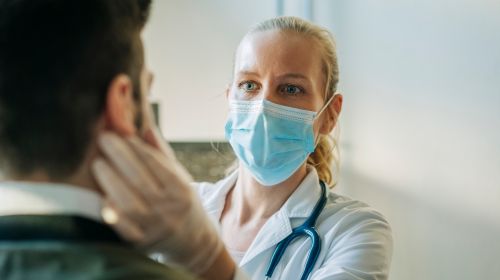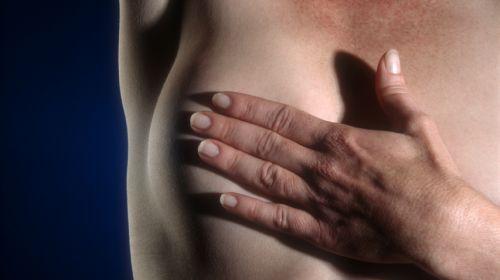Non-Hodgkin lymphomas (NHL) are different forms of malignant (malignant) tumors that spread in lymph tissue. Which parts of the body are affected, which therapy options there are and how high the life expectancy is, depends on various factors.
- There are more than 30 different non-Hodgkin lymphomas. The picture shows Burkitt's lymphoma.
- © Getty Images / KATERYNA KON / SCIENCE PHOTO LIBRARY
Compared to other cancers, such as breast cancer or prostate cancer, non-Hogkin lymphomas are rather rare. In 2016, more than 9,000 men and more than 8,000 women in Germany were newly diagnosed with non-Hodgkin lymphoma. Elderly people are particularly affected, and those who are diagnosed are on average around 70 years old.
Article content at a glance:
What is Non-Hodgkin Lymphoma?
Under the term "non-Hodgkin lymphoma", medical professionals summarize more than 30 different cancers of the lymphatic system that are not Hodgkin's disease.
Non-Hodgkin lymphomas are degenerate lymph cells that multiply unchecked due to changes in the genetic make-up. Lymph cells are white blood cells (leukocytes) that play an important role in the immune system. Their task is to identify harmful intruders such as pathogens and to combat them.
In non-Hodgkin lymphoma, the lymph nodes are usually affected. But there is also lymphatic tissue in other areas of the body, which can be affected. Including:
Non-Hodgkin's lymphomas are also divided into:
- B-cell non-Hodgkin lymphomas
- T-cell non-Hodgkin lymphomas
These two types are further differentiated in terms of their malignancy and growth rate:
indolent, low-malignant (slowly growing, less malignant) forms: They are the most common at 70 percent. They grow rather slowly and often do not cause any symptoms in the early course of the disease.
aggressive, highly malignant (more malignant) lymphomas: This type of non-Hodgkin lymphoma is less common, but more malignant. But they respond better to therapy attempts than less malignant lymphomas.
The most common types of non-Hodgkin lymphoma are:
- multiple myeloma
- diffuse, large B-cell lymphoma (DLBCL)
- chronic lymphocytic leukemia
- follicular lymphoma (FL)
Symptoms: how do you recognize non-Hodgkin lymphoma?
The symptoms that are caused by non-Hodgkin lymphoma are partly non-specific. This means that the symptoms can also occur in other clinical pictures.
In non-Hodgkin's lymphoma, swollen lymph nodes, especially in the neck region, and often in several parts of the body at the same time, are typical. In non-Hodgkin lymphomas, the affected lymph nodes are permanently enlarged and swell more and more as the disease progresses. They are difficult to move under the skin and do not hurt, even when touched.
These are important criteria for differentiating between infectious diseases. Because swollen lymph nodes are also typical for these, but in the event of an infection they are mild to severe pain. In addition, the swelling usually decreases after a few days with an infection, in contrast to swollen lymph nodes in cancer.
The following symptoms are also possible with non-Hodgkin lymphoma:
If the bone marrow is affected, this can also lead to a disruption of blood formation. If too few red blood cells are formed, this is expressed as anemia. If, on the other hand, too few platelets are formed, the deficiency can lead to punctiform skin hemorrhages, so-called petechiae.
Depending on the location of the lymph node swelling, those affected often report the following symptoms:
- Lymph node swelling in the liver / spleen: pain in the abdomen
- swollen lymph nodes behind the breastbone: irritable cough and feeling of pressure in the chest
- Lymph node enlargement in the back of the abdomen: back pain
The symptoms of non-Hodgkin lymphoma also typically differ in the course of the disease.
Causes and Risk Factors for Non-Hodgkin
In most cases it cannot be clearly stated what causes non-Hodgkin's lymphoma to develop. Medical professionals assume that several factors interact in non-Hodgkin lymphoma.
There are a number of risk factors that favor the development of individual lymphomas. For example:
- immunodeficiency
- Chemotherapy treatment
- individual autoimmune diseases
- radioactive radiation
- Viruses: The Epstein-Barr virus, for example, favors Burkitt's lymphoma
- Bacteria: Helicobacter pylori, for example, are associated with MALT lymphoma of the stomach
- Benzene and related substances
Lifestyle factors and other environmental toxins are also suspected of promoting non-Hodgkin lymphoma. A family history can also play a role.
Diagnosis: This is how Non-Hodgkin is diagnosed
If non-Hodgkin lymphoma is suspected, a specialist in internal medicine or oncology should be consulted. The doctor will inquire about the symptoms and ask the patient about his medical history (anamnesis).
During the subsequent physical examination, the doctor will scan the lymph nodes if non-Hodgkin lymphoma is suspected.
Further diagnostic procedures can then follow:
Examination of the blood: Anemia and a lack of blood platelets (thrombocytopenia) and white blood cells typical of later disease processes can be determined simply and easily by taking a blood sample.
Examination of tissue samples: If non-Hodgkin is suspected, a lymph node is completely removed and examined under a microscope. In some cases, tissue samples from other possibly diseased tissues can be useful for diagnosis.
Imaging procedures: If the tissue examination confirms the suspicion of lymphoma, x-rays, ultrasound or computed tomography (CT) are possible. These diagnostic imaging tests also provide information about the stage of the disease.
Therapy for non-Hodgkin lymphoma
The therapy options initially depend on the type of lymphoma. Only when this is known can a suitable treatment be defined. In addition, the stage of the disease, the age and the general state of health of the patient play an important role in the choice of the right treatment concept. The right time to start therapy is also influenced by these factors.
Radiation and chemotherapy for non-Hodgkin lymphoma
Radiation Therapy: In the case of low-grade lymphomas, radiation therapy is sufficient in many cases. The prerequisite for this is that the non-Hodgkin lymphoma is in an early stage, i.e. not very advanced.
Chemotherapy: In the later course of the disease with low-grade lymphoma, chemotherapy is usually the only option. Chemotherapy is usually also indicated for aggressive, highly malignant forms of non-Hodgkin. The affected person is given so-called cytostatics, which slow down cell growth and division.
Antibody therapy for non-Hodgkin lymphoma
A relatively new therapeutic method is treatment with antibodies, which is carried out in addition to chemotherapy. The treatment method, also known under the term immune chemotherapy, has so far only been possible for certain forms of B-cell non-Hodgkin lymphoma. The administered antibodies recognize certain proteins on the surface of the degenerated cells and destroy them.
Course and life expectancy: is non-Hodgkin curable?
How a non-Hodgkin disease progresses varies greatly from person to person. When asked about the chances of recovery and life expectancy in non-Hodgkin lymphoma, many factors are decisive. Above all, how well the therapy works and at what stage of the disease it is started.
In addition, the age of the patient, their general health and the type of lymphoma play a major role.
Rapidly growing, i.e. highly malignant non-Hodgkin lymphomas are usually easier to treat. In otherwise good health, highly malignant non-Hodgkin lymphomas can usually be cured in the advanced stages of the disease.
In the case of indolent, low-malignant lymphones, on the other hand, complete healing is often only possible if appropriate treatment is started early on in the disease.
According to the Robert Koch Institute (RKI), the average relative five-year survival rate for non-Hodgkin lymphomas is 70 percent for women and 68 percent for men.


